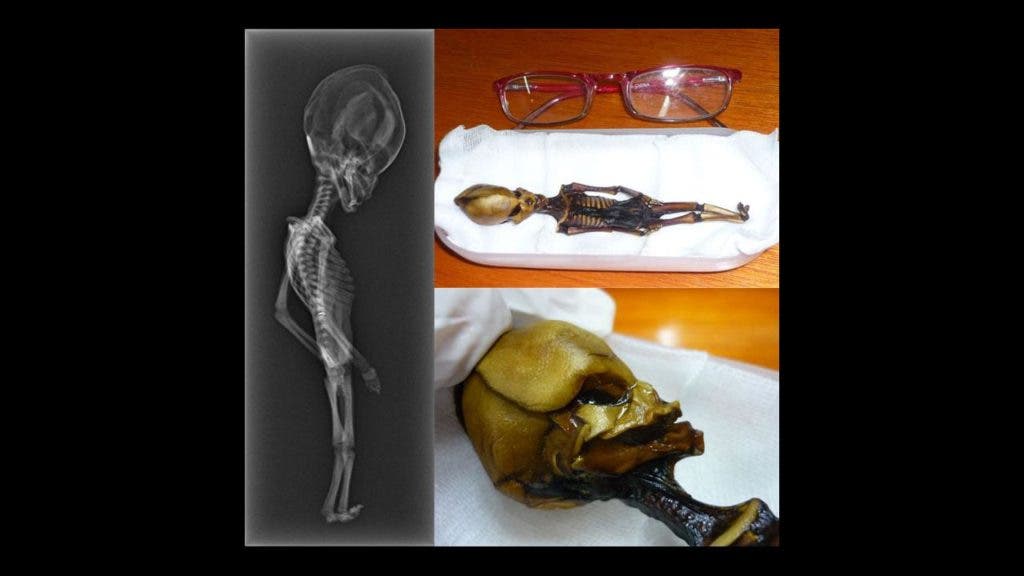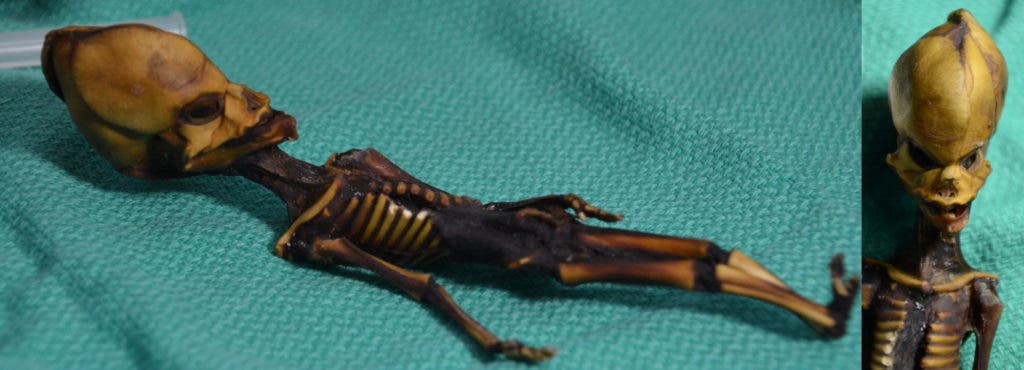It’s the strangest human mummy you’ll likely ever see, and it’s not an alien.
In 2003, researchers found an incredibly bizarre mummy in Chile. Measuring a mere 6 inches, with an extremely elongated skull and several extreme abnormalities, it only remotely looked human. The questions came in fast, and they poured in: what is? Is it human — and if it is human, why does it look so strange? The specimen was auctioned off to a Spanish businessman which delayed proper studies but now, results from the first comprehensive analysis are finally in.
“This was an unusual specimen with some fairly extraordinary claims put forward. It would be an example of how to use modern science to answer the question what is it?” says senior author Garry Nolan from Stanford University.
Not an alien
Thankfully, Ata, as the skeleton was named (short for Atacama), contains some high-quality DNA which researchers were able to sequence. They compared Ata’s DNA with human and non-human primate reference genomes, including chimpanzee and rhesus macaque. To the chagrin of UFO hunters, researchers learned that Ata is very much human and even more — she has Chilean ancestry.

DNA results will certainly disappoint UFO conspiracists, but Ata is very much human — although she’s incredibly small and suffers from several malformations. Image credits: Garry Nolan.
Although researchers believed Ata was a few years old, Nolan now believes she was either stillborn or only lived for a few days. It’s unclear exactly when Ata lived, though the skeleton seems to be at least several decades old — probably some 40 years.
Next, researchers moved on to look for more clues regarding Ata’s extremely short stature and unusual features, which aside from the obvious skull malformation, include an abnormal rib count and premature bone age. They found multiple mutations in genes associated with diseases such as dwarfism, scoliosis, and musculoskeletal abnormalities. Surprisingly, all these malformations can be explained with a relatively short list of gene mutations in genes associated with bone development, Nolan says.
However, Ata is more than just an interesting specimen. Since she had the grave misfortune of suffering such severe abnormalities, she can teach us quite a bit about how the gene mutations can affect the human body.
“This is a great example of how studying ancient samples can teach us how to analyze modern day medical samples” says co-author Atul Butte, from the UCSF.
Aside from her skeletal malformations, Ata also probably suffered from something called congenital diaphragmatic hernia — a fairly common, but also life-threatening condition where a baby’s diaphragm doesn’t form correctly. Nolan told The Guardian:
“She was so badly malformed as to be unable to feed. In her condition, she would have ended up in the neonatal ICU, but given where the specimen was found, such things were simply not available,” he said.
“While this started as a story about aliens, and went international, it’s really a story of a human tragedy. A woman had a malformed baby, it was preserved in a manner and then ‘hocked’ or sold as a strange artefact. It turns out to be human, with a fascinating genetic story from which we might learn something important to help others. May she rest in peace.”
Journal Reference: Bhattacharya S, Li J, Sockell A, Kan M, Bava F, Chen, S, Ávila-Arcos M, Ji X, Smith E, Asadi N, Lachman R, Lam H, Bustamante C, Butte A, Nolan G. 2018. Whole genome sequencing of Atacama skeleton shows novel mutations linked with dysplasia. Genome Research doi: 10.1101/gr.223693.117.
Edit: In its original form, this article had an error regarding Ata’s age.










